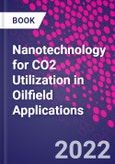Nanotechnology for CO2 Utilization in Oilfield Applications delivers a critical reference for petroleum and reservoir engineers to learn the latest advancements of combining the use of CO2 and nanofluids to lower carbon footprint. Starting with the existing chemical and physical methods employed for synthesizing nanofluids, the reference moves into the scalability and fabrication techniques given for all the various nanofluids currently used in oilfield applications. This is followed by various, relevant characterization techniques. Advancing on, the reference covers nanofluids used in drilling, cementing, and EOR fluids, including their challenges and implementation problems associated with the use of nanofluids.
Finally, the authors discuss the combined application of CO2 and nanofluids, listing challenges and benefits of CO2, such as carbonation capacity of nanofluids via rheological analysis for better CO2 utilization. Supported by visual world maps on CCS sites and case studies across the industry, this book gives today's engineers a much-needed tool to lower emissions.
Please Note: This is an On Demand product, delivery may take up to 11 working days after payment has been received.
Table of Contents
1. Introduction��
2. Synthesis�and characterization of nanofluids for oilfield applications��
3. Rheological characterization of nanofluids��
4. Why CO2?��
5. CO2 Enhanced Oil Recovery (EOR) process and injection process��
6. Carbonated nanofluids for EOR and improved carbon storage��
7. Mass transfer by molecular diffusion��
8. Rock dissolution and formation damage in CO2 EOR��
9. Role of nanofluids in improving CO2 storage and stability in subsurface reservoir��
10. Density-driven natural convection during CO2 geo-sequestration��
11. Dimensionless numbers and scaling criteria��
12. Retention of nanoparticles in porous media: Implications for fluid flow�
13. CO2 foams��
14. Solid CO2 storage in nanofluids for improved CO2 utilization��
15. Conclusion and future research direction�








